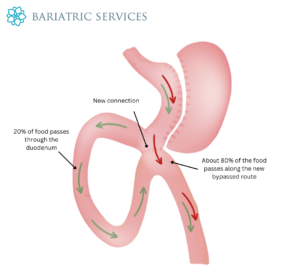 The Bariatric Services is pleased to announce that we have implemented an innovative bariatric surgical procedure called Sleeve-Bypass/ gastric bypass with sleeve gastrectomy., also known as single anastomosis sleeve ileal bypass (SASI). This is the newest and highly effective weight loss intervention.
The Bariatric Services is pleased to announce that we have implemented an innovative bariatric surgical procedure called Sleeve-Bypass/ gastric bypass with sleeve gastrectomy., also known as single anastomosis sleeve ileal bypass (SASI). This is the newest and highly effective weight loss intervention.
Sleeve-bypass is suitable for patients with a body mass index (BMI) of 35kg/m2 and above. It may also be considered for patients with a lower BMI who have obesity-related conditions such as type 2 diabetes, sleep apnoea, or dyslipidemia.
How does Sleeve-Bypass surgery work?
In sleeve-bypass surgery, the first step is a classic sleeve operation, where 80% of the stomach is removed longitudinally, leaving behind a banana-shaped tube with a capacity of 100-150ml. The removed section of the stomach is removed from the abdominal cavity. Then, an anastomosis is created between the remaining gastric tube and the middle part of the small intestine. This allows food to move through the stomach using two different paths: natural pathway through the pylorus and the duodenum and direct pathway through the new connection to the middle part of the small intestine.
Studies have shown that approximately 80% of the food bypasses the stomach and goes directly to the small intestine after the surgery, while 20% follows the natural pathway. In classical bypass surgeries, such as standard bypass and mini bypass, food is completely diverted from the duodenum and the beginning of the small intestine. In sleeve-bypass, however, the food continues to stimulate all parts of the intestines. The goals of this seemingly complex procedure are actually very clear, such as reducing the risk of vitamin and micronutrient deficiencies and minimizing the risk of bacterial overgrowth and resulting diarrhea in the bypassed section of the intestine. The surgery is performed laparoscopically, like other bariatric surgeries.
Sleeve-bypass is effective as a weight loss procedure because:
- Reducing the stomach volume and the fact that 80% of the food bypasses the beginning of the small intestine leads to changes in intestinal hormone secretion. These hormonal changes affect our hunger, satiety, and food preferences, allowing weight loss without experiencing hunger or food-related stress as in a conventional diet.
- Reducing the stomach volume enables an earlier and longer-lasting feeling of fullness. Food portions are small, and eating must be done slowly and with thorough chewing. The stomach capacity may increase slightly over a few months, but never to the previous level. Overeating or eating too quickly can cause discomfort in the stomach.
- As a significant portion of the ingested food bypasses the small intestine, not all of it is digested and absorbed, especially in the case of fats. It is also well-known that food reaching the middle part of the small intestine directly from the stomach leads to a strong feeling of fullness, reducing appetite and influencing food choices.
 The Bariatric Services is pleased to announce that we have implemented an innovative bariatric surgical procedure called
The Bariatric Services is pleased to announce that we have implemented an innovative bariatric surgical procedure called